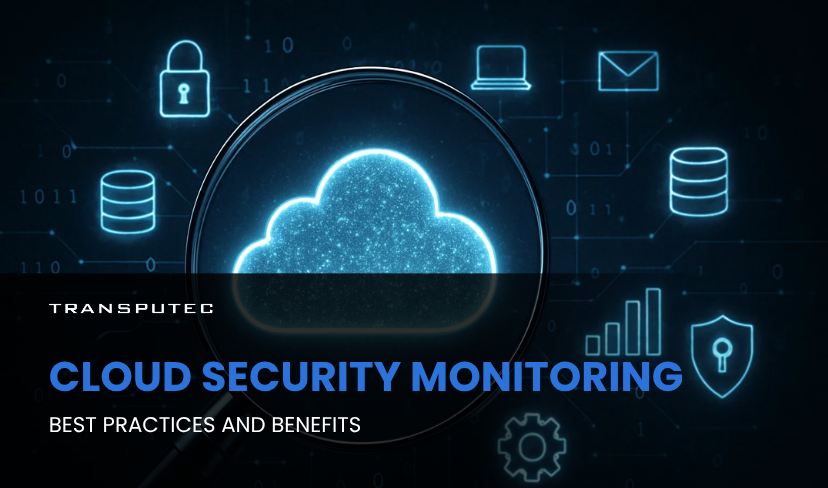Written by KRITIKA SINHA | MARKETING
Cybercriminals aren’t breaking in, they’re logging in.
That’s the chilling reality many business owners face today. With organisations rapidly shifting to cloud environments, security protocols often lag. Employees are accessing sensitive data from multiple locations, third-party integrations are expanding attack surfaces, and misconfigured cloud settings have become open invitations for data breaches. According to IBM’s 2023 Cost of a Data Breach Report, cloud-based breaches cost organisations an average of $4.75 million, higher than any other breach source.
So, what’s the solution? Cloud Security Monitoring.
This blog unpacks what cloud security monitoring is, why it’s vital for modern businesses, best practices to adopt, and the tangible benefits it delivers. We’ll also show how Transputec’s cloud security expertise can help you stay ahead of emerging threats while keeping your business agile and compliant.
What Is Cloud Security Monitoring?
Cloud security monitoring is the continuous process of observing, tracking, and analysing activities within a cloud infrastructure to detect, prevent, and respond to potential security threats. It covers everything from login attempts, data transfers, application behaviour, to network anomalies — all in real time.
Where traditional IT environments offer controlled perimeters, the cloud introduces dynamic, decentralised systems where visibility becomes complex. That’s why businesses need automated tools and expert services like those from Transputec to ensure they aren’t blind to security gaps.
Why Businesses Can’t Ignore Cloud Security Monitoring
1. Cloud Environments Are Prime Targets for Cyberattacks
As businesses migrate to cloud platforms, attackers follow. Cloud environments are complex and often misconfigured, making them vulnerable to breaches. Without proper monitoring, businesses may not even detect an intrusion until after data has been compromised, leading to financial loss and reputational damage.
2. Increasing Regulatory Pressure
Laws like GDPR, HIPAA, and PCI-DSS now require businesses to demonstrate continuous monitoring and secure handling of data. Cloud security monitoring helps organisations meet these compliance standards, avoid hefty fines, and maintain customer trust.
3. Lack of Visibility in the Cloud
Unlike traditional IT environments, the cloud doesn’t have a defined perimeter. With distributed workloads and remote access, it becomes difficult to track who is doing what and when. Cloud security monitoring provides centralised visibility and helps detect unusual or unauthorised activity in real-time.
4. Threats Are Evolving Rapidly
Cyber threats are no longer just malware and phishing. Today’s attacks are stealthy, AI-driven, and capable of bypassing standard defences. Advanced monitoring tools use behavioural analytics and machine learning to identify suspicious patterns before damage is done.
5. Business Continuity and Trust Depend on It
Downtime, data loss, or breaches can paralyse operations. Cloud security monitoring ensures early threat detection and quick response, minimising the impact on your business. Maintaining operational integrity and customer confidence starts with knowing your cloud is secure.
Ready to Secure Your Cloud with Confidence?
Connect with us today for our free consultation!
Key Features of Cloud Security Monitoring
1. Real-Time Threat Detection
Cloud security monitoring tools continuously scan for suspicious activity across your cloud environment. They detect unusual behaviours, such as failed login attempts, data exfiltration, or abnormal user access, as they happen, enabling immediate investigation and response.
2. Automated Alerts and Responses
These systems are designed to automatically trigger alerts when predefined thresholds or suspicious behaviours are detected. In some cases, they can even initiate responses, such as blocking access, isolating a resource, or escalating incidents, without manual intervention.
3. Centralised Visibility Across Environments
Whether you’re using AWS, Azure, Google Cloud, or a hybrid setup, monitoring platforms provide a unified dashboard that consolidates data from all services. This helps security teams quickly spot issues, track activity, and make informed decisions without switching between platforms.
4. Compliance and Audit Support
Cloud security monitoring tools generate detailed logs and audit trails, which are essential for meeting regulatory requirements. They also help demonstrate security practices during audits and simplify the documentation process for standards like GDPR, HIPAA, or ISO 27001.
5. Behavioural Analytics and AI Integration
Modern tools don’t just rely on static rules, they use machine learning to establish baselines of normal activity. When something deviates from that baseline, such as a user suddenly accessing large amounts of sensitive data, it’s flagged for review, enabling proactive threat mitigation.
Best Practices for Effective Cloud Security Monitoring
1. Define Clear Monitoring Objectives
What assets need protection? What kind of activities should raise red flags? Align your cloud security monitoring goals with your business objectives and risk appetite.
2. Implement Multi-Layered Monitoring
Don’t just monitor endpoints. Monitor networks, APIs, containers, applications, and databases. This holistic approach uncovers hidden threats.
3. Centralised Log Management
Use a Security Information and Event Management (SIEM) solution to aggregate and analyse logs across all cloud services. Transputec helps implement platforms like Splunk or Microsoft Sentinel, optimised for real-time insights.
4. Use AI-Driven Threat Detection
Traditional pattern matching is no longer enough. Leverage tools that apply machine learning to detect previously unknown threats.
5. Regularly Update Security Rules and Policies
As your cloud environment evolves, so should your monitoring rules. Schedule regular reviews and integrate changes proactively.
6. Conduct Routine Security Audits
Regular audits, especially from a third-party like Transputec, help identify blind spots and optimise configurations.
Benefits of Cloud Security Monitoring
1. Early Detection Minimises Damage
With continuous monitoring, threats are identified in real time, often before they escalate into full-scale breaches. This allows security teams to act quickly, isolate the threat, and minimise the impact on systems, data, and operations.
2. Improved Incident Response Time
Cloud security monitoring streamlines how incidents are managed. With automated alerts and workflows, response teams can react faster and more effectively, reducing downtime and preventing further compromise.
3. Cost Savings from Preventing Breaches
According to IBM, the average cost of a data breach in 2023 was $4.45 million. By detecting and responding to threats early, monitoring tools help prevent costly breaches, legal consequences, and reputational damage, saving money in the long term.
4. Enhanced Accountability and Transparency
Monitoring tools record every user action and system event, creating a detailed audit trail. This enhances accountability within your organisation, supports internal investigations, and builds trust with stakeholders and clients.
5. Scalability with Business Growth
As your cloud environment expands, cloud security monitoring solutions scale effortlessly with your infrastructure. Whether you add new applications, users, or services, the monitoring system can adapt, ensuring consistent protection across your evolving digital ecosystem.
How Transputec Delivers Cloud Security Monitoring Excellence
Transputec offers end-to-end cloud security monitoring services tailored to your specific environment and compliance needs. Whether you operate in a single-cloud, hybrid, or multi-cloud architecture, Transputec’s experts can:
- Configure and manage industry-leading monitoring tools.
- Integrate AI-driven threat detection systems.
- Offer 24/7 security operations centre (SOC) support.
- Provide actionable insights and regular security reports.
Conclusion
Cloud environments offer flexibility, scalability, and cost-efficiency, but they also introduce new security challenges. That’s why cloud security monitoring is no longer optional; it’s essential.
From real-time threat detection to compliance assurance and risk mitigation, effective cloud monitoring empowers organisations to stay secure while remaining agile. By implementing best practices and partnering with experts like Transputec, your business can confidently harness the cloud without compromising safety.
Ready to secure your cloud environment? Contact us today to connect with an expert and get started with Transputec’s cloud security monitoring services.

Secure Your Cloud, Secure Your Future. Ready to Take the Next Step?
Contact us today to schedule a consultation with our experts.
FAQs
1. What makes Transputec different in cloud security monitoring?
Transputec combines decades of IT expertise with cutting-edge tools and a proactive approach. Our tailored solutions are not one-size-fits-all; we assess your infrastructure and compliance needs to deliver effective, actionable monitoring services.
2. Can Transputec support multi-cloud environments?
Yes. Transputec’s monitoring solutions cover AWS, Microsoft Azure, Google Cloud, and hybrid environments. We help unify visibility and streamline your security operations across all platforms.
3. How quickly can Transputec implement a cloud monitoring system?
Depending on the complexity of your environment, we can deploy a functional monitoring solution within a few days to a few weeks. We prioritise minimal disruption and fast onboarding.
4. Is cloud security monitoring suitable for SMEs, or only large enterprises?
Businesses of all sizes are targets for cyberattacks. Transputec offers scalable monitoring services that can grow with your business, making them ideal for SMEs and enterprises alike.
5. What kind of reports and alerts will I receive?
You’ll receive customised reports based on your KPIs, automated alerts for suspicious activities, and detailed audit logs. Our team also provides expert analysis and recommendations regularly.




